
Content Marketing Strategy: A Definitive Guide
Content marketing is undoubtedly the most effective way to attract new customers and grow your audience. But there’s one challenge many brands face when it comes to adopting it, and that’s putting a strategy behind it.
A content marketing strategy is the linchpin of your content marketing efforts. Without one, you risk having a disjointed effort with no focused purpose behind it — and a shabbier marketing ROI as a result.
This is likely why only 19% of content marketers rate their efforts as “very successful.” Everyone else falls in the middle of the road — and 9% even reported their efforts were unsuccessful.

Image Source: SEMRush
You don’t have to fall into those latter categories.
This guide contains everything you need to know about developing a content marketing strategy that delivers results for your business. In the sections that follow, we will:
- Go over the building blocks of a strong content marketing strategy
- Walk through the action steps for executing your strategy
- Outline the benefits a content marketing strategy will bring to your business
- Remind you what not to do when it comes to content marketing
- Share some tips and best practices for long-term content marketing success
Let’s get started!
Quick Takeaways:
- Content marketing strategies puts a company’s content marketing efforts into a centralized, goal-oriented plan.
- Content should always be aligned with customer needs and optimized for search engines.
- Setting SMART goals and defining KPIs for your content marketing strategy set it up for greater success.
- Content marketing strategies perform best when they are multichannel and include varied content types.
- A data-driven approach to content marketing (that includes industry, market, company, and customer level data) is necessary to make smart strategy decisions.
What is a content marketing strategy?
To understand what makes a great content marketing strategy, you first need to answer the question: what is content marketing in the first place? In summary, content marketing is a way for companies to showcase their thought leadership with SEO and content insights. It uses different content types (like blogs, videos, infographics) and distribution channels (like websites, social media, and email) to reach audiences in varied ways.
A content marketing strategy is a detailed, focused plan that centralizes the components of your content efforts — content assets, distribution channels, data, technology tools, human resources and more.
It includes:
- All important brand information and guidelines
- An execution plan
- Details about the what, when, and who for each task
- KPIs and a process for measuring them
When you develop a content marketing strategy, you take a holistic approach to creating and sharing content in a way that furthers your goals and helps your business to grow. You leverage your content intentionally to build brand awareness, drive organic web traffic, attract new customers, and establish your brand expertise.
Launching a successful content marketing strategy takes time, planning, and dedication. It also takes patience to see the full ROI.
Content marketing is not always a quick win, and those who create the right kind of strategy know that building results over time is part of the game. But when you do, you reap a return on investment exponentially bigger than you would with disjointed content marketing efforts.
Why do you need a content marketing strategy?
The way consumers interact with brands — from B2B enterprises all the way down to your everyday individual — is changing. The internet has put buyers in charge of the buying process. They look online to find answers to their questions, solutions to their problems, and brands to help them do both.
This is happening in both B2B and B2C industries. Recent research found that 81% of retail consumers research products and brands online before making a purchase or going to a store. B2B buyers conduct 57-70% of their research before ever reaching out to a brand directly.
When it comes to engaging potential customers during this research period, it’s your content that’s doing most of the work.
Some other quick reasons your company needs a content marketing strategy:
- 93% of all online experiences begin with a search. If you’re not ranking on Google results pages, you’re likely invisible to your target audience.
- 81% of consumers say brand trust is a deciding factor in purchase decisions. High-quality content is one of the most effective trust builders brands have in their arsenal.
- Content marketing strategies empower brands to establish their expertise, industry reputation, and competitive positioning. Without content, your competitors control the narrative.
Building blocks of a winning content marketing strategy
Defined goals
It’s impossible to create a strong content marketing strategy without setting goals — detailed, well-defined, time-bound goals. Your goals lay the foundation for the rest of your strategy, give it direction, and keep your team accountable.
You can start with goals related to your overall vision, then build out to include smaller goals your content can help you accomplish. Be sure your goals are aligned hierarchically — all of your smaller goals should have a clear purpose for helping to achieve the larger, overarching ones.
The SMART goal framework can help you create goals that check these boxes and set your strategy in the right direction.
A qualified team
The makeup of your team determines quite a bit about your content marketing strategy. Your team determines your human bandwidth as well as your knowledge, skills, and industry expertise. Some companies have an internal team responsible for all marketing initiatives. Many companies outsource content to an agency. Others take a hybrid approach by having their internal team partner with a hired agency.
So which is right for you? To decide, consider your internal team first. Do they have the time and qualifications to execute your content marketing strategy? If they do, you might be able to execute in-house. If not, outsourcing or creating a hybrid team may be better options for you. In that case, you’ll need to determine your budget and needs, vet potential agencies, and choose the agency that fits best with your company.
Your content
The bread and butter! Your strategy should aim to include a diverse set of high-value content that will be delivered across several channels. We’ll cover more about content types and channels in the next section, but here are a few best practices to keep in mind no matter which ones you choose:
Align your content to customer pain points
Pain points are specific problems that lead your customers to seek out your solutions. Nothing resonates more with potential customers than content that shows a true understanding of their pain points. It builds trust that your solutions can successfully deliver what they need.
The value proposition canvas is a powerful tool for identifying customer pain points and finding the best ways to demonstrate your brand value in relation.
Make all content SEO content
Your content must be designed for search engine optimization. Without ranking on Google, even the best content will remain invisible to its intended audience. Refer to our SEO checklist for everything you need to know about how to do this.
Your KPIs
KPIs are what keep you from falling into the no-man’s-land of never knowing if your content marketing strategy is delivering results. KPIs determine success in relation to a specific activity or initiative. Your content marketing strategy will have several target KPIs that you use to measure the different components of your strategy.
Important content marketing KPIs include:
- Organic traffic – how many visitors get to your website from organic search results
- Search rankings – how high your content is ranking on Google results pages
- Conversions – number of users who took meaningful action on your website (i.e. subscribed to a newsletter, made a purchase, etc.)
- Leads – number of inquiries or interested prospects generated by your content
- ROI – the monetary return you get from your investment in your content strategy
Benefits to your business
Business benefits are manifold when you have a great content marketing strategy. Let’s take a look at some of the most important ones:
Search visibility
Search visibility is the share of traffic you’re getting from organic search results. A good content marketing strategy increases your existing Google rankings and the breadth of keywords you rank for, increasing your overall search visibility.
Tools like Moz can calculate your search visibility by taking your ranked keywords, estimating CTR based on each ranking position (weighting higher ranked keywords appropriately), adding all of your CTRs, and dividing by the number of keywords you’re tracking.
Even if you’re not calculating search visibility as a number, you can trust that if your rankings are climbing, your search visibility is doing the same.
Organic traffic
Organic traffic is traffic you earn from unpaid sources — namely, search engines. It accounts for more than half of all traffic that companies are earning across industries. By comparison, paid search only accounts for 10%, social media accounts for 5%, and all other channels combined account for 34%.
It’s also the top metric content marketers are using to measure their content marketing strategy’s success:
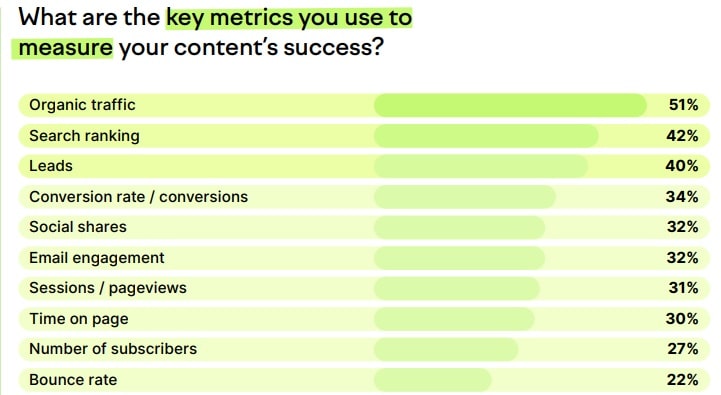
Image Source: SEMRush
Marketers are focusing so much on organic traffic because its benefits are so impactful. It provides a cost advantage to PPC ads and other paid channels. It’s also an indicator of brand credibility and consumer trust because it requires the consistent creation of authentic, high-value, insightful content.
Brand authority
Brand authority is your company’s established expertise and reputation in your niche. Content is one of the main drivers of brand authority, which is not only important to customers, but also to peers and the search engine crawlers ranking your content.
When you create consistent and high-value content powered by a strong content marketing strategy, you demonstrate your expertise across the topics that are most important to the people and companies in your industry. You build critically important brand trust, and you see it reflected across your KPIs — rankings, organic traffic, backlinks, leads, conversions and more.
Leads and conversions
You can’t earn more revenue for your company without leads and conversions — and content marketing has been found to earn them at exponentially higher rates than other marketing methods. In fact, companies with a content marketing strategy earn 3x the leads and 6x the conversions than those using traditional marketing alone.
You can boost the lead generation results you earn from your content marketing strategy even more with lead magnets. Lead magnets are high-value assets that solve a user problem or help them accomplish a task. They’re typically exchanged in return for a user’s contact information.
Common types of lead magnets include checklists, templates, ebooks, whitepapers, webinars, reports, and demo videos.
Compounding results
Content marketing may take time, planning, and patience in its initial stages, but the long-term ROI makes it well worth the investment. When you put a solid content marketing strategy in place and execute it effectively, you can expect to see compounding results over time.
What do we mean by that?
Evergreen content — or content with a long shelf life for relevance — will continue to earn results year after year and have ripple effects on your brand’s traffic, social media shares, engagement, and overall demand. See the visual below for just how important this really is:
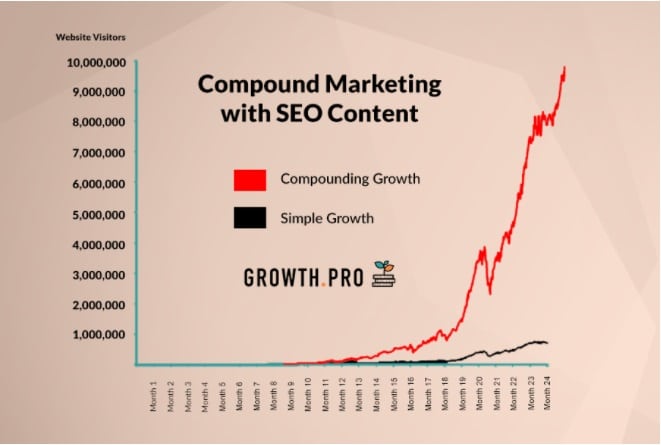
How to develop and execute your content marketing strategy
Now you know the basics — why content marketing is important, the building blocks of your strategy, and the benefits it will have on your business. It’s time to execute. Follow these 8 steps to build a winning content marketing strategy customized to your unique business needs.
Audit your current content
Performing a content audit gives you a handle on what resources you already have in your library. Believe it or not, this can be a gold mine! Repurposing old content is one of the top ways brands increase the ROI on their content and give traffic a boost.
You can also use your content audit to identify gaps you need to fill and opportunities to pursue with new content. You can deep-dive into how to do this with our A-Z Guide to Doing a Content Audit.
Define your target audience
Targeting content to the right audience at the right time is a critical component of your content marketing strategy. But in order to do it, you first need to know who your target audience(s) is. There are three important parts of this step:
- Identifying the problems, pain points, and needs people experience when they’re seeking your company’s solutions
- Empathizing with their emotions and experience
- Providing the solution (in the form of content and, ultimately, your product or service)
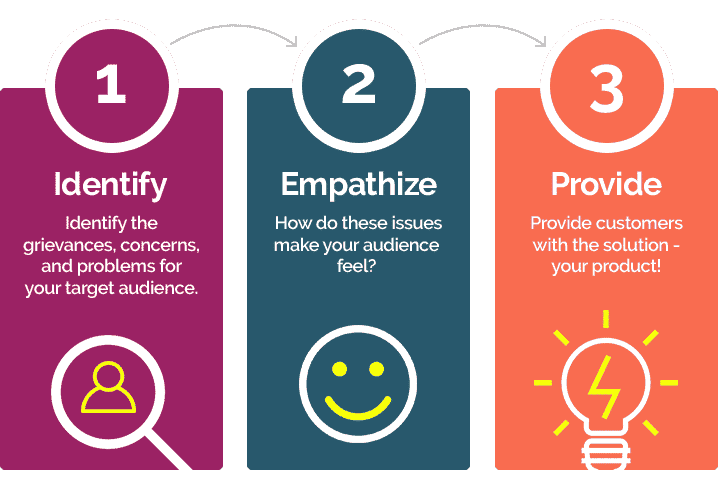
When you develop your content with empathy, you tap into the true motivations people have for finding and considering your brand in the first place. You are better able to create content that makes your readers feel understood, and creates a connection that is more likely to result in a lead or sale for your company.
You can use tools like the empathy map from Alexander Osterwalder’s and Yves Pigneur’s book Business Model Generation to put this concept into action.
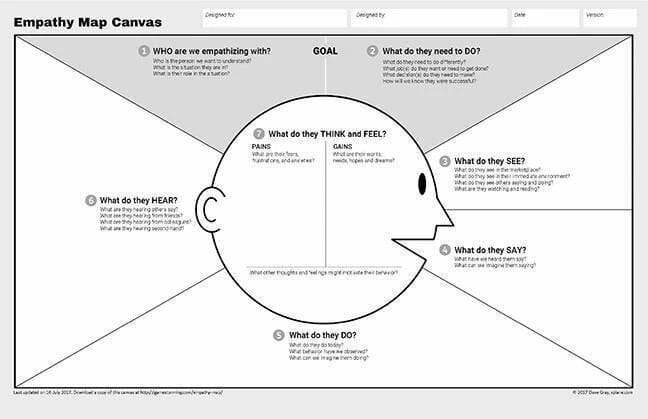
Then, you can use the buyer persona framework to pinpoint exactly who is included in your target audience and what their unique pain points are.
Remember, too, that buyers are not the only users included in your audience. Also consider those who are simply interested in the topics you cover or who enjoy following your brand. These users may not buy from you directly (at least not right away) but they are potential brand advocates and can help you grow your following. Look to understand their perspectives and include them in your content marketing strategy the same way you do for potential buyers.
Once you’ve completed this step, you’re ready to move on to planning your content.
Come up with topic ideas
What topics will your content cover? It’s one of the most important decisions you’ll make as you plan your content marketing strategy, and we’ve got good news: you don’t have to go it alone.
While your marketing team will know the broad content pillars and high-level topics that will resonate most with your target audience, you can use keyword research tools to drill down into the specific searches they’re performing related to those topics.
So, for instance: if you’re a content marketing agency (like us!), one of the biggest topics your customers look for is probably SEO. But SEO is a broad topic! It’s important to find the specific things about SEO that your customers want to know.
You can access free keyword research tools like SEMRush’s Keyword Magic Tool or Ahrefs Free Keyword Generator, enter “SEO,” and the tool will give you dozens (or more) of search queries being made around the topic. You can then build content around those queries.
With this approach, we’ve been able to create niche educational content about SEO, such as:
- The Complete SEO Checklist for SaaS Companies
- The Content-Driven Guide to Enterprise SEO
- How Your Small Business Can Improve SEO with Content Marketing
- Content Marketing and Local SEO for B2B Businesses
You’ll notice these articles incorporate different target audiences (SaaS companies, large enterprises, small businesses, B2B companies) and cover specific SEO topics most relevant for them.
At the same time, we’ve still been able to create more general SEO content that’s relevant for all of these groups:
Without keyword research, our attempts to cover SEO for our web visitors at both broad and niche levels would have been a guessing game. Don’t make your content creation a shot in the dark! Use keyword research for optimized content relevance, rankings, traffic, and ROI.
Outline content channels
How will you deliver your content? With more channels than ever available for content delivery, you’ve got plenty of options to choose from. One thing is for sure: your content marketing strategy should be multichannel, sharing content in all of the places your customers are looking for it. Here are the the important ones to know:
Blog
Your blog serves as the hub of your content library. Publishing frequent, relevant, high-quality blog content is the best way to drive organic traffic to your website.
Consumers prefer email over every other form of brand communication. You can use it to share newsletters and blog content, nurture leads, promote special offers and more.
Social media
Today more than half of consumers perform brand research on social media and 90% buy from brands they follow on their personal accounts. Sharing your content on social media makes it more visible and shareable to your audience.
Video
Video is taking over! Cisco predicts by the end of this year that video will account for 82% of all online traffic, and people consume it more than any other type of content! You can use video to create educational content (similar to your blogs), share social media stories, or host online events.
Podcasts
More than a quarter of Americans are weekly podcast listeners, and that number is on the rise. Podcasting is a creative way to offer unique content like interviews with industry leaders or commentary on current industry trends and events. Podcasts are fairly easy to produce and publish, too.
Which channels should you choose?
Our recommendation is to start with 2-3 channels you’re most comfortable using and where you’ll get the most traction. You should never leave out your blog — like we mentioned already, it’s the driver of your content sharing across other channels. Over time, you can build on your success and expand to other channels as you’re able.
Document your strategy
Documenting your content marketing strategy is critical so that everyone involved understands brand guidelines, goals, tasks that need to get done, when they need to be done, and who is responsible. A documented content marketing work plan also gives you a high-level view of your strategy so that you understand how its components are working together toward achieving your goals.
Research from the Content Marketing Institute found that content marketers with a documented strategy were more effective overall than those without one. Our content marketing strategy template walks you through each step of documenting your strategy and execution plan.
Develop your content calendar
Content calendars outline and track when every piece of content will be created, delivered, and published. They help you optimize the timing of your content, and ultimately ensure that nothing falls through the cracks. Visit our comprehensive guide to content calendars for more on this (and several templates you can download and use!).
Start publishing!
More is more when it comes to publishing your content. You should plan to be publishing multiple times per week across channels in order to capture the most ROI from your content marketing strategy.
HubSpot research found that brands that publish 11-16 blog articles per month earned 3x the traffic than those who published less frequently.
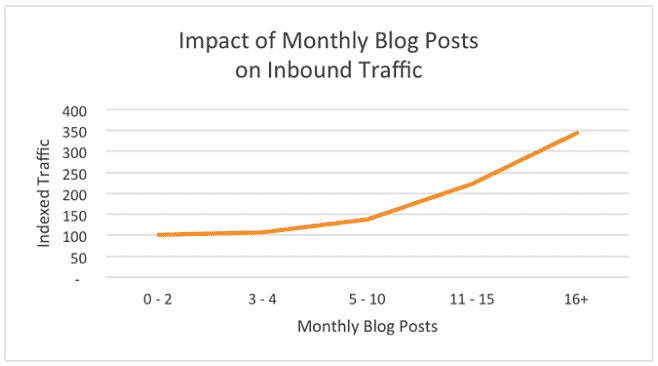
Image Source: HubSpot
And like we mentioned before, sharing your blog content through additional channels like email and social media meets your users where they are, makes your content more visible, and makes it more likely to be shared by readers.
Measure your performance
Remember those KPIs you set before you built your content marketing strategy? Measuring them should be a frequent part of your execution plan. When you measure your KPIs, you can identify gaps and opportunities early and adjust your strategy accordingly.
One of the best ways to hold yourself accountable to this is to maintain a data dashboard that includes your KPIs (see the one we use at MIG below) and hold regular meetings with your team to evaluate progress.
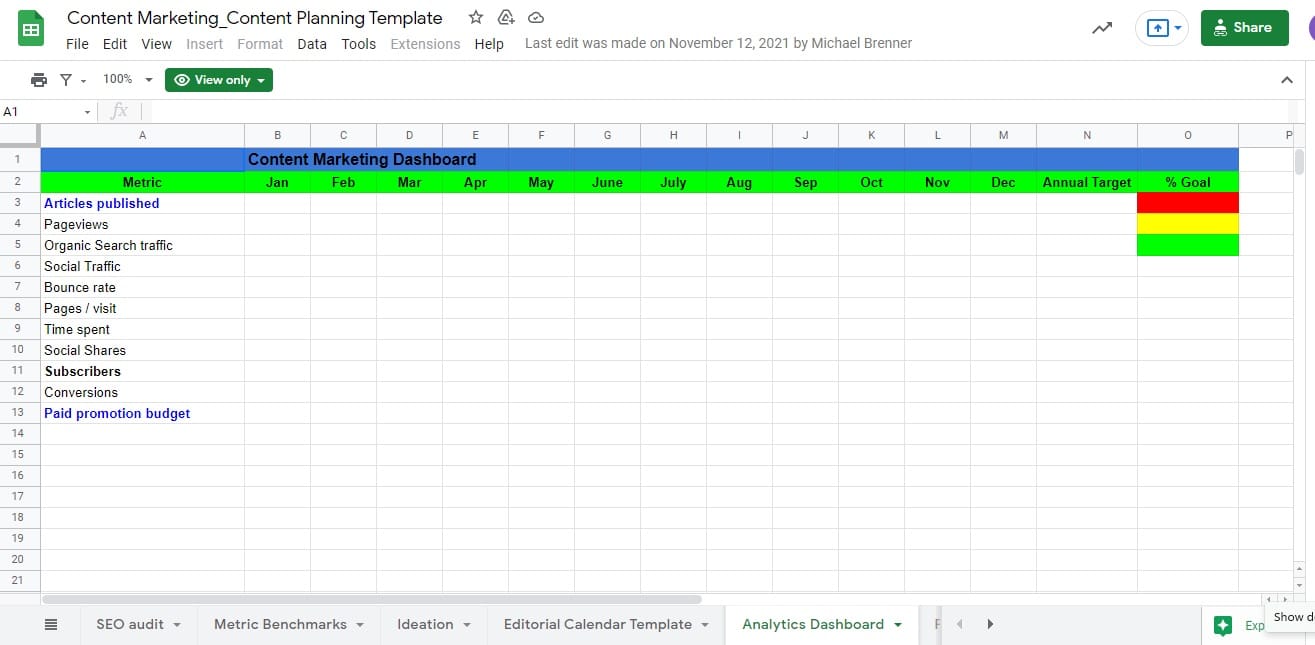
More resources
If you’re looking for additional resources on the process of developing your strategy, check out our article on How to Develop an Effective Content Marketing Strategy. This article dives deeper into goal setting, target audience, content priorities, strategy documentation and more.
What not to do: content marketing edition
Skip steps in the process
It can be tempting to skip right to the content, but the ROI is truly in the planning. Personas, keyword research, content calendars, etc. — these are the parts of your content marketing strategy that drive content success later down the line.
So, no shortcuts. Don’t skip steps in the planning process. Put the right pieces in place and you’ll be much better able to execute a winning strategy that delivers results.
Publish randomly
Publishing without a schedule inevitably leads to inconsistency and gaps in the time between publishing. Don’t make your publishing schedule random. Research the best times to publish for your audience, find a cadence, make your content calendar detailed, and stick to the plan!
Be too salesy
Remember — content marketing is a long game. Adding a hard sell to every piece of content is a sure way to turn readers away. Instead, let your content do your selling for you by demonstrating your expertise and commitment to delivering value. Know that over time, you’ll see bigger results by building loyalty and trust with your audience.
Fail to measure performance
It’s easy to let performance measurement fall to the wayside. After all, you did the work to develop and launch your content marketing strategy. You’re busy! You can always reschedule that assessment meeting later . . . right?
Here’s the thing: when you fail to measure your performance, you are throwing opportunities for improvement (and bigger ROI) out the window. You can’t know how well your strategy is working if you don’t measure your performance against your KPIs. Don’t be that company who has no idea if they’re earning results.
Build processes and block out times for measuring your strategy’s performance and stay committed to doing it over time.
Tips for long-term success
Get creative
Your content marketing strategy is a chance to showcase your brand’s unique personality and voice. Get creative about how you do it!
Explore how to cover topics with different content types, put your own new spin on already-covered topics, and don’t be afraid to have an opinion about trends and current events in your industry. Here are some creative content marketing examples to inspire you!
Encourage internal collaboration
Everyone within your organization — from your executive team to marketing to sales to product design and more — has a different perspective. Even if you’re working in a small business or startup with a small team, everybody’s experience is different depending on their role and the work they do.
Including these varied perspectives when you’re developing your content marketing strategy helps you present well-rounded, informed views of the topics that matter to your audience. Even after you have your strategy developed, encourage your content team to leverage internal expertise across functions when creating content.
Publish different types of content
Maintaining a diverse library of content opens more distribution channels and opportunities for engagement. Don’t stick to just one type of content! Blog posts, ebooks, infographics, video, photos, podcasts, case studies, whitepapers, emails, social media posts — you have these and more to choose from.
You can create more than one content type for one topic, too. In fact, this is one of the best ways to repurpose great content.
MIG, for example, has a blog article about how to write the perfect blog post, two infographics included in the article that we also share on their own, and an email nurture series we send to clients that reinforces much of this content to help them succeed.
You don’t have to publish every type of content (and I actually don’t recommend trying to do that) but limiting yourself to just one gives you tunnel vision and limits the ways your audience can interact with your brand.
Engage with users
Content provides many avenues for interacting directly with your audience. Take advantage! It’s often the little things that have the biggest impact here. Take time to respond to blog and social media comments, for example, can make people feel connected to your brand.
You can also try collecting feedback through short forms or surveys, building community with groups or discussion boards, going “live” on social media to answer questions, and holding online events like webinars based on your educational content.
Use visuals
It’s all about visual content these days. The numbers don’t lie:
- Blog articles with images are viewed 94% more than those without them
- Tweets with images are retweeted 150% more than text-only Tweets
- 8 out of 10 consumers report they have purchased a product after watching a brand’s video
Many brands find visual content to be intimidating, but you can start with a simple approach and build on it. Infographics, for example, are shared more than any type of visual content. Creating one awesome infographic about an important topic can give you a huge traffic boost.
You can also source high-quality images and videos from other sources (like we’ve done throughout this article) to make your written content more visual without having to handle the design and production yourself.
Be data-driven
Last but definitely not least: keep your strategy data-driven. We know this applies to KPIs and performance measurement, but there are other places data should play a role in your content marketing strategy. For example:
- Using web visitor data to refine your target audience
- Personalizing your content using customer data
- Looking at larger industry trends and forecasts to help you make decisions
- Performing market research to understand competitive positioning
In these ways and more, data can keep you informed, make you a smarter decision maker, and make your content marketing strategy more effective.
Over to You
You’ve got the knowledge and tools you need! It’s time to develop your company’s winning content marketing strategy. Looking for some real-world inspiration? Check out these content marketing strategy case studies to learn how companies have put these principles into action for real results.
When it comes to content, Marketing Insider Group has the experience and resources that can support you in your efforts. Our team of writers and SEO experts can deliver you optimized, ready-to-publish content every week for one year (or more!).
Check out our SEO Blog Writing Service or schedule a quick consultation to learn more!






